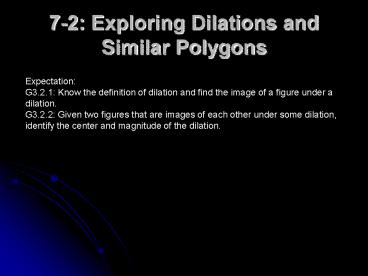7-2: Exploring Dilations and Similar Polygons - PowerPoint PPT Presentation
1 / 26
Title:
7-2: Exploring Dilations and Similar Polygons
Description:
7-2: Exploring Dilations and Similar Polygons Expectation: G3.2.1: Know the definition of dilation and find the image of a figure under a dilation. – PowerPoint PPT presentation
Number of Views:111
Avg rating:3.0/5.0
Title: 7-2: Exploring Dilations and Similar Polygons
1
7-2 Exploring Dilations and Similar Polygons
Expectation G3.2.1 Know the definition of
dilation and find the image of a figure under a
dilation. G3.2.2 Given two figures that are
images of each other under some dilation,
identify the center and magnitude of the dilation.
2
Size Changes
- When we start with one figure and make it bigger
or smaller, it is called a size change
transformation. - The original figure is called the preimage and
the resulting figure is called the image.
3
- The magnitude, k, of a size change is how many
times bigger (or smaller) the image is than the
preimage.
4
Types of Dilations
- Contraction reduction the image is smaller than
the preimage magnitude is greater than 0, but
less than 1. - Expansion enlargement the image is larger than
preimage magnitude is greater than 1.
5
Dilations
The following terms all indicate a size
change dilation dilitation contraction expansion
6
- A picture is enlarged by a scale factor of 125
and then enlarged again by the same scale factor.
If the original picture was 4 x 6, how large is
the final copy?
7
- By what scale factor was the original picture
enlarged?
8
Size Changes With Coordinates
- To perform a size change of given magnitude on a
polygon with known coordinates, multiply the
magnitude of the size change by each of the
coordinates of the polygon.
9
- If D(x,y) (3x,3y), what is the image of the
point (-5,8)? - What is the scale factor of the dilation?
10
- A triangle has coordinates A(3,-1), B(4,3) and
C(2,5). The triangle will undergo a dilation
using a scale factor of 3. Determine the
coordinates of the vertices of the resulting
triangle.
11
- Triangle ABC is a dilation of triangle XYZ. Use
the coordinates of the 2 triangles to determine
the scale factor of the dilation. - A(-1, 1), B(-1, 0), C(3,1)
- X(-3, 3), Y(-3, 0), Z(9, 3)
12
- Triangle XYZ is a dilation of ?ABC. Use the
coordinates of the 2 triangles to determine the
scale factor of the dilation. - A(-1, 1), B(-1, 0), C(3,1)
- X(-3, 3), Y(-3, 0), Z(9, 3)
13
Size Change Distance Theorem
- The image of a segment transformed by a dilation
with scale factor k is parallel to and k times
the length of the preimage.
14
- Before a size change, the slope of AB is 4 and AB
8. After a size change of magnitude .5, what is
the slope of AB and AB?
15
Center of a Dilation
- The center of any dilation is where the lines
through all corresponding points intersect.
16
C is the center of the dilation mapping ?XYZ onto
?LMN
C
Y
X
Z
M
L
N
17
- Given two figures which are dilations of each
other, how can you find the center of the
dilation?
18
Determine the center of the dilation.
19
Similar Figures
Defn Two figures, F and G, are similar (written
F G) iff corresponding angles are congruent and
corresponding sides are proportional. Dilations
always result in similar figures!!!
20
Similar Figures
If WXYZ ABCD, then
?W ? ?A ?X ? ?B ?Y ? ?C ? Z ? ?D
21
- If ?ABC is similar to ?DEF in the diagram below,
then m?D ? - 80
- 60
- 40
- 30
- 10
B
E
80
D
F
40
A
C
22
Determine whether the triangles are similar.
Justify your response!
9.75
13
9
12
3.75
5
23
Scale Factor
The scale factor (magnitude) between similar
figures is the ratio of the lengths of
corresponding sides.
24
Triangle ABC is similar to triangle DEF.
Determine the scale factor of DEF to ABC (be
careful the order is important), then calculate
the lengths of the unknown sides.
25
In the figure below, ?ABC is similar to ?DEF.
What is the length of DE? A. 12 B. 11 C. 10 D.
7? E. 6?
26
Assignment
- pages 351-353,
- 13 25 (odds), 29 and 41































